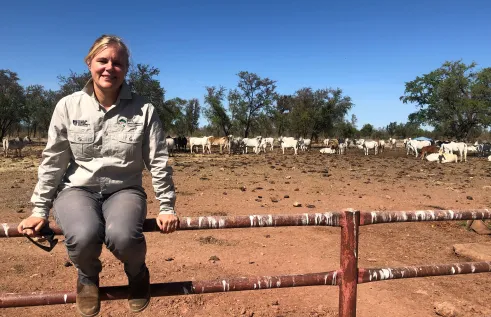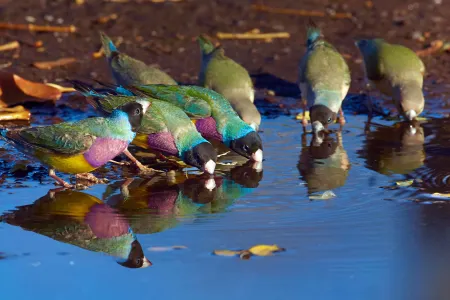News article
Powerful genetic tool aids endangered Gouldian finch
For the first time, Australian scientists have shown that environmental DNA (eDNA) can be used to detect the presence of an endangered bird species simply by collecting a cupful of water from the pools where they drink.
eDNA has emerged as a powerful tool to trace rare and threatened aquatic species but its application in the detection of threatened terrestrial species is still largely untested.
Researchers from Charles Darwin University (CDU), The University of Western Australia, and the Northern Territory Department of Environment and Natural Resources (DENR) have developed a genetic probe that targets and identifies the eDNA of the endangered Gouldian finch, a rainbow-coloured grassfinch endemic to the savanna woodlands of northern Australia.
CDU’s Professor Karen Gibb, who led the study funded by the Australian Government’s National Environmental Science Program, said the eDNA test had the potential to increase knowledge of the distribution and habitat use of Gouldian finches.
“This is essential information to guide land management decisions that will assist the recovery of wild populations,” Professor Gibb said.
Gouldian finches were once found in their thousands from the Kimberley region of Western Australia across to Cape York Peninsula in Queensland.
Pastoralism and the timing and intensity of fires has been linked to the historical decline in the numbers of Gouldian finches, most likely owing to the reduced availability of the grass seeds that form the major part of their die
Because the finches are found in small groups across the vast, remote and sparsely populated north of Australia it is also difficult to track changes in the numbers of Gouldian finches from year to year.
When Gouldian finches drink at waterholes, they leave traces of their DNA behind that can now be detected after they’ve flown away.
The researchers developed a two-in-one eDNA qPCR test that recognises and makes multiple copies of a specific region of mitochondrial DNA found in Gouldian and related finches as well as a species-specific probe to detect only Gouldian finch DNA.
DENR threatened species scientist Brydie Hill said that this relatively simple sampling method will allow the department to develop collaborative monitoring programs across the range of the Gouldian finch.
“Land managers, such as the Jawoyn Rangers, can then map where the finches occur across the landscape and compare it with their fire management to see how their activities are benefitting the recovery of Gouldian finches,” she said.
The study, titled “Development and validation of an environmental DNA test for the endangered Gouldian finch” published in Endangered Species Research was authored by Kimberley Day, Hamish Campbell, Karen Gibb and Alea Rose (CDU), Alaric Fisher and Brydie Hill (Northern Territory DENR) and Simon Jarman (University of Western Australia).
Related Articles

Where rubber meets the road: Old tyres are key to building tougher roads
Almost half of the Northern Territory’s worn-out tyres end up in landfills – with the rest exported interstate for recycling – but a study led by Charles Darwin University (CDU) is repurposing the discarded rubber to build stronger, sustainable roads that meet the NT’s unique needs.
Read more about Where rubber meets the road: Old tyres are key to building tougher roads
Social media subjecting Black women to radicalised digital policing
Influencers use oppression, manipulation and weaponisation to police Black women on social media, according to new research uncovering the entrenched nature of digital racism.
Read more about Social media subjecting Black women to radicalised digital policing
Moo-ving the boundaries: New research evaluates virtual fences for use on NT cattle stations
Cattle producers in Northern Australia face unique challenges when adapting tools like virtual fences on their properties, but new research from Charles Darwin University (CDU) is set to break down the barriers to this technology.
Read more about Moo-ving the boundaries: New research evaluates virtual fences for use on NT cattle stations
